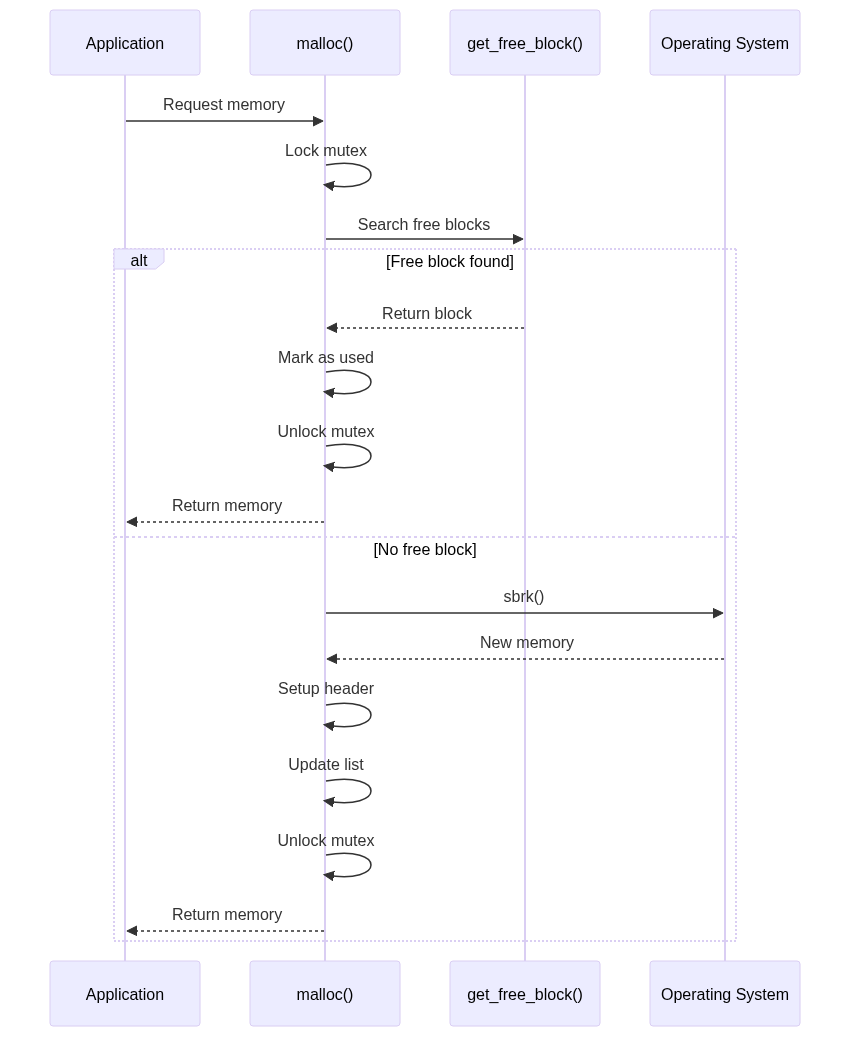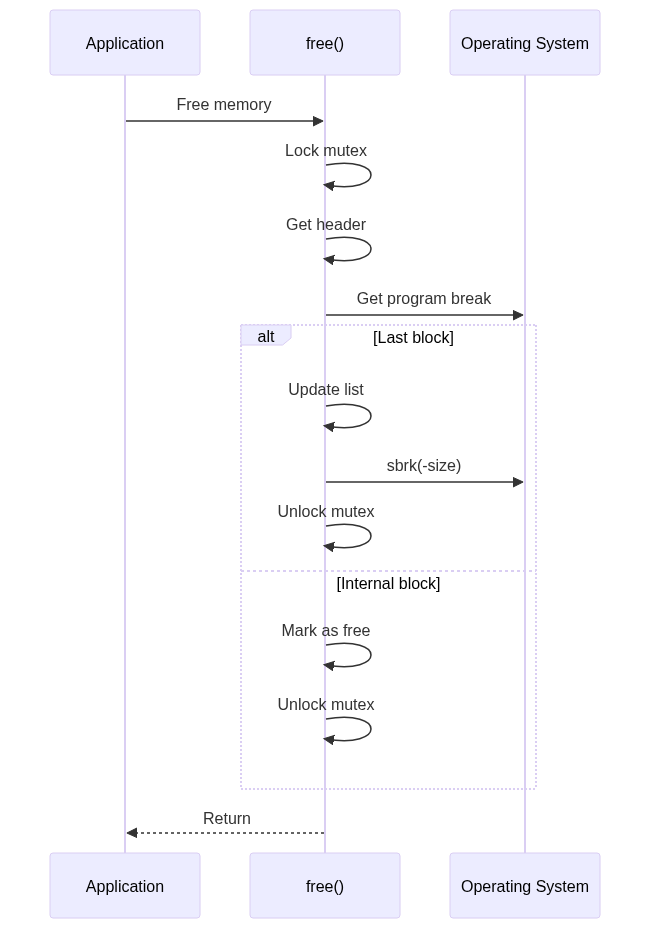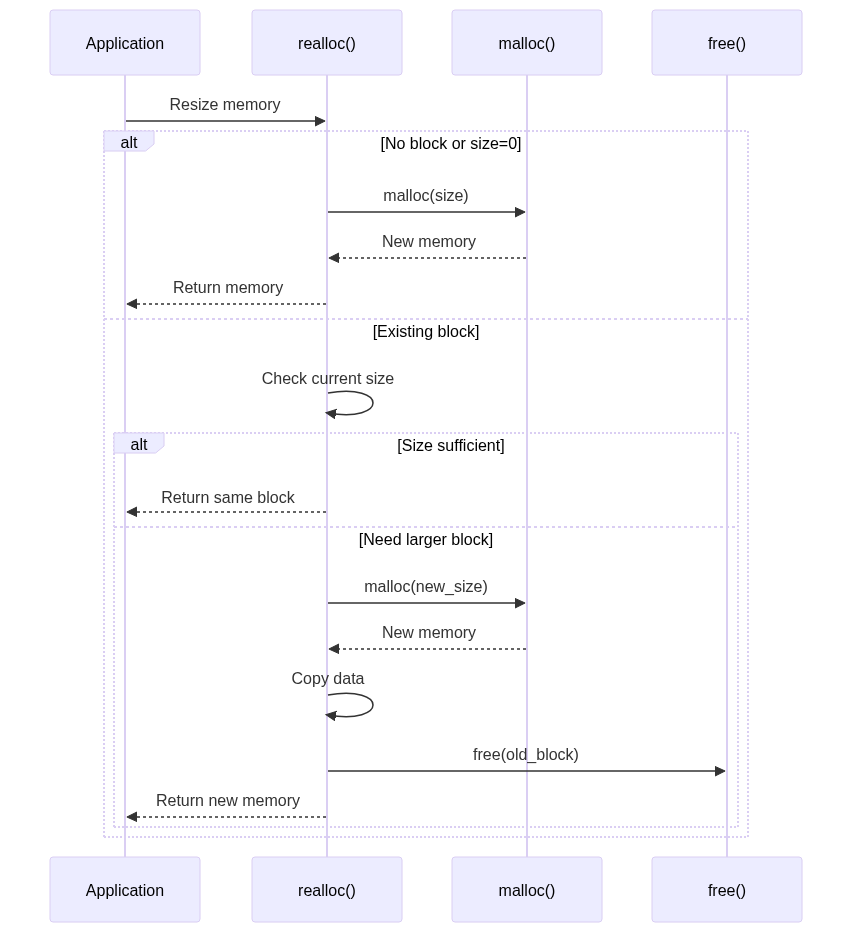Everything About Memory Allocators: Write a Simple Memory Allocator
A comprehensive guide to memory allocators, covering allocation strategies, heap management, and implementing a custom memory allocator from scratch with performance considerations.
Introduction
Memory allocation is a fundamental aspect of systems programming that every developer should understand. This article provides an in-depth exploration of implementing a basic memory allocator in C, covering malloc(), free(), calloc(), and realloc(). While our implementation won’t match the sophistication of production allocators like ptmalloc or jemalloc, it will help you understand the core concepts.
Memory Layout Fundamentals
Before diving into implementation details, let’s understand how memory is organized in a Linux process. A program’s virtual address space typically consists of several segments:
- Text Segment (Code Segment)
- Contains executable instructions
- Read-only
- Shared among processes running the same program
- Data Segment
- Contains initialized global and static variables
- Split into read-only and read-write sections
- BSS (Block Started by Symbol)
- Contains uninitialized global and static variables
- Automatically initialized to zero by the kernel
- Takes no actual space in the executable file
- Heap
- Dynamically allocated memory
- Grows upward (toward higher addresses)
- Managed by malloc/free
- Starts after BSS
- Stack
- Automatic variables
- Function call frames
- Grows downward (toward lower addresses)
- Automatically managed
The program break (brk) marks the end of the heap segment. Our memory allocator will primarily interact with this boundary using the sbrk() system call.
Memory Management Basics
The Program Break
The program break is a virtual address that marks the end of the process’s data segment. We can manipulate it using two system calls:
- brk(void *addr) - Sets the program break to a specific address
- sbrk(intptr_t increment) - Adjusts the program break by a specified increment
Key points about sbrk():
- sbrk(0) returns the current program break address
- sbrk(positive_value) increases heap size
- sbrk(negative_value) decreases heap size
- Returns (void*)-1 on error
Building a Memory Allocator
Core Data Structures
Our allocator needs to track allocated memory blocks. We’ll use a linked list approach with each block containing a header structure.
1
2
3
4
5
6
7
8
9
10
11
12
13
14
15
typedef char ALIGN[16];
union header {
struct {
size_t size; // Size of the block
unsigned is_free; // Block status flag
union header *next; // Next block in list
} s;
ALIGN stub; // Force 16-byte alignment
};
typedef union header header_t;
// Global variables
header_t *head = NULL, *tail = NULL;
pthread_mutex_t global_malloc_lock;
The header structure serves several purposes:
- Tracks block size
- Maintains free/allocated status
- Links blocks together
- Ensures proper memory alignment
Memory Block Headers
Each allocated block needs a header to store metadata:
1
2
3
4
5
6
typedef struct block_header {
size_t size; // Size of the block (including header)
int is_free; // 1 if free, 0 if allocated
struct block_header* next; // Pointer to next block
struct block_header* prev; // Pointer to previous block
} block_header_t;
The header contains:
- size: Total size including the header
- is_free: Flag indicating if the block is available
- next/prev: Pointers for maintaining a doubly-linked list
Implementation Details
The memory allocator implementation involves several key design decisions and optimizations:
Block Alignment
All memory blocks must be aligned to word boundaries for optimal performance:
1
2
#define ALIGNMENT 8
#define ALIGN(size) (((size) + (ALIGNMENT-1)) & ~(ALIGNMENT-1))
Block Splitting and Coalescing
When allocating memory, we may need to split large blocks:
1
2
3
4
5
6
7
8
9
10
11
12
13
14
15
16
17
18
static block_header_t* split_block(block_header_t* block, size_t size) {
if (block->size >= size + sizeof(block_header_t) + ALIGNMENT) {
block_header_t* new_block = (block_header_t*)((char*)block + size);
new_block->size = block->size - size;
new_block->is_free = 1;
new_block->next = block->next;
new_block->prev = block;
if (block->next) {
block->next->prev = new_block;
}
block->next = new_block;
block->size = size;
return new_block;
}
return NULL;
}
Memory Coalescing
When freeing blocks, adjacent free blocks should be merged:
1
2
3
4
5
6
7
8
9
10
11
12
13
14
15
16
17
18
19
static void coalesce_blocks(block_header_t* block) {
// Merge with next block if free
if (block->next && block->next->is_free) {
block->size += block->next->size;
block->next = block->next->next;
if (block->next) {
block->next->prev = block;
}
}
// Merge with previous block if free
if (block->prev && block->prev->is_free) {
block->prev->size += block->size;
block->prev->next = block->next;
if (block->next) {
block->next->prev = block->prev;
}
}
}
Core Functions Implementation
malloc()
The malloc() implementation follows these steps:
- Check for valid size request
- Look for existing free block of sufficient size
- If found, mark as used and return
- If not found, request new memory from OS
- Setup header and return pointer
Here’s the implementation:
1
2
3
4
5
6
7
8
9
10
11
12
13
14
15
16
17
18
19
20
21
22
23
24
25
26
27
28
29
30
31
32
33
34
35
void *malloc(size_t size) {
if (!size) return NULL;
pthread_mutex_lock(&global_malloc_lock);
// Try to find a free block
header_t *header = get_free_block(size);
if (header) {
header->s.is_free = 0;
pthread_mutex_unlock(&global_malloc_lock);
return (void*)(header + 1);
}
// Need new block from OS
size_t total_size = sizeof(header_t) + size;
void *block = sbrk(total_size);
if (block == (void*)-1) {
pthread_mutex_unlock(&global_malloc_lock);
return NULL;
}
// Initialize new block
header = block;
header->s.size = size;
header->s.is_free = 0;
header->s.next = NULL;
// Update list pointers
if (!head) head = header;
if (tail) tail->s.next = header;
tail = header;
pthread_mutex_unlock(&global_malloc_lock);
return (void*)(header + 1);
}
free()
The free() implementation handles memory deallocation:
1
2
3
4
5
6
7
8
9
10
11
12
13
14
15
16
17
18
19
20
21
22
23
24
25
26
27
28
29
30
31
32
33
34
void free(void *block) {
if (!block) return;
pthread_mutex_lock(&global_malloc_lock);
header_t *header = (header_t*)block - 1;
void *programbreak = sbrk(0);
// Check if block is at the end of heap
if ((char*)block + header->s.size == programbreak) {
// Remove from list
if (head == tail) {
head = tail = NULL;
} else {
header_t *tmp = head;
while (tmp) {
if (tmp->s.next == tail) {
tmp->s.next = NULL;
tail = tmp;
break;
}
tmp = tmp->s.next;
}
}
// Return memory to OS
sbrk(0 - sizeof(header_t) - header->s.size);
} else {
// Mark block as free
header->s.is_free = 1;
}
pthread_mutex_unlock(&global_malloc_lock);
}
calloc()
calloc() allocates memory and initializes it to zero:
1
2
3
4
5
6
7
8
9
10
11
12
13
14
15
16
17
void *calloc(size_t num, size_t nsize) {
size_t size;
void *block;
if (!num || !nsize) return NULL;
size = num * nsize;
// Check for multiplication overflow
if (nsize != size / num) return NULL;
block = malloc(size);
if (!block) return NULL;
// Zero out the memory
memset(block, 0, size);
return block;
}
realloc()
realloc() changes the size of an existing allocation:
1
2
3
4
5
6
7
8
9
10
11
12
13
void *realloc(void *block, size_t size) {
if (!block || !size) return malloc(size);
header_t *header = (header_t*)block - 1;
if (header->s.size >= size) return block;
void *ret = malloc(size);
if (ret) {
memcpy(ret, block, header->s.size);
free(block);
}
return ret;
}
Thread Safety Considerations
Our implementation uses a global mutex to ensure thread safety:
1
2
3
4
pthread_mutex_t global_malloc_lock;
// Initialize in main or constructor
pthread_mutex_init(&global_malloc_lock, NULL);
However, this approach has limitations:
- Single lock creates contention
- sbrk() isn’t thread-safe
- No protection against foreign sbrk() calls
Testing and Usage
Let’s test our allocator with a comprehensive example:
1
2
3
4
5
6
7
8
9
10
11
12
13
14
15
16
17
18
19
20
21
22
23
24
25
26
27
28
29
30
31
32
33
34
int main() {
printf("Testing custom memory allocator\n");
// Test basic allocation
void* ptr1 = my_malloc(100);
printf("Allocated 100 bytes at %p\n", ptr1);
void* ptr2 = my_malloc(200);
printf("Allocated 200 bytes at %p\n", ptr2);
// Test freeing
my_free(ptr1);
printf("Freed first allocation\n");
// Test allocation after free (should reuse space)
void* ptr3 = my_malloc(50);
printf("Allocated 50 bytes at %p\n", ptr3);
// Test calloc
void* ptr4 = my_calloc(10, sizeof(int));
printf("Allocated zeroed array at %p\n", ptr4);
// Test realloc
ptr4 = my_realloc(ptr4, 20 * sizeof(int));
printf("Reallocated array to %p\n", ptr4);
// Cleanup
my_free(ptr2);
my_free(ptr3);
my_free(ptr4);
printf("All tests completed successfully\n");
return 0;
}
Sequence Diagrams
Understanding the flow of memory allocation operations is crucial. Here are sequence diagrams showing the interaction between different components:
malloc() Sequence
sequenceDiagram
participant App as Application
participant Malloc as my_malloc()
participant Heap as Heap Manager
participant OS as Operating System
App->>Malloc: Request memory (size)
Malloc->>Heap: Find suitable block
alt Block found
Heap->>Malloc: Return existing block
Malloc->>Heap: Split block if needed
else No block found
Malloc->>OS: Request more memory (sbrk)
OS->>Malloc: Extend heap
Malloc->>Heap: Create new block
end
Malloc->>App: Return pointer to allocated memory
free() Sequence
sequenceDiagram
participant App as Application
participant Free as my_free()
participant Heap as Heap Manager
App->>Free: Free memory (pointer)
Free->>Heap: Mark block as free
Free->>Heap: Check adjacent blocks
alt Adjacent blocks are free
Heap->>Free: Coalesce blocks
Free->>Heap: Update block list
end
Free->>App: Return (void)
Memory Layout Evolution
graph TD
A[Initial Heap] --> B[First malloc(100)]
B --> C[Second malloc(200)]
C --> D[free(first block)]
D --> E[malloc(50) - reuses space]
subgraph "Heap States"
A1["|------ Free Block ------|"]
B1["|Used(100)|-- Free --|"]
C1["|Used(100)|Used(200)|Free|"]
D1["|Free(100)|Used(200)|Free|"]
E1["|Used(50)|Free|Used(200)|Free|"]
end
This visualization shows how the heap evolves as allocations and deallocations occur, demonstrating block splitting, coalescing, and reuse.
Further Reading
- The Linux Programming Interface by Michael Kerrisk
- Advanced Programming in the UNIX Environment by W. Richard Stevens
- Understanding the Linux Virtual Memory Manager by Mel Gorman
- Doug Lea’s Memory Allocator Documentation
- jemalloc Documentation and Source Code
Conclusion
This implementation demonstrates the fundamental concepts of memory allocation while keeping things simple enough to understand. Production allocators add many optimizations:
- Multiple allocation strategies
- Memory pooling
- Thread-local caches
- Sophisticated fragmentation handling
- Memory mapping for large allocations
Key takeaways:
- Memory allocation involves both userspace and kernel space interaction
- Thread safety requires careful consideration
- Memory layout understanding is crucial
- Simple implementations help learn fundamentals
- Production allocators are much more complex
Remember that this implementation is for educational purposes. Production systems should use established allocators that have been thoroughly tested and optimized.


